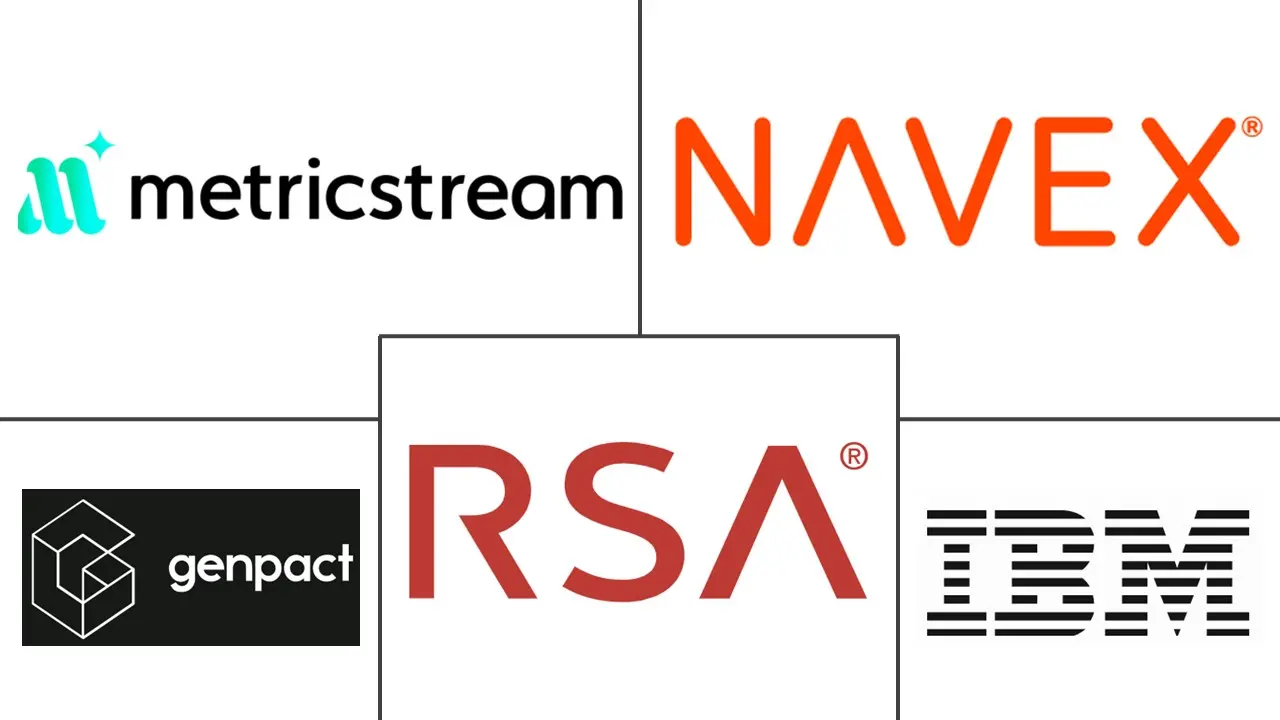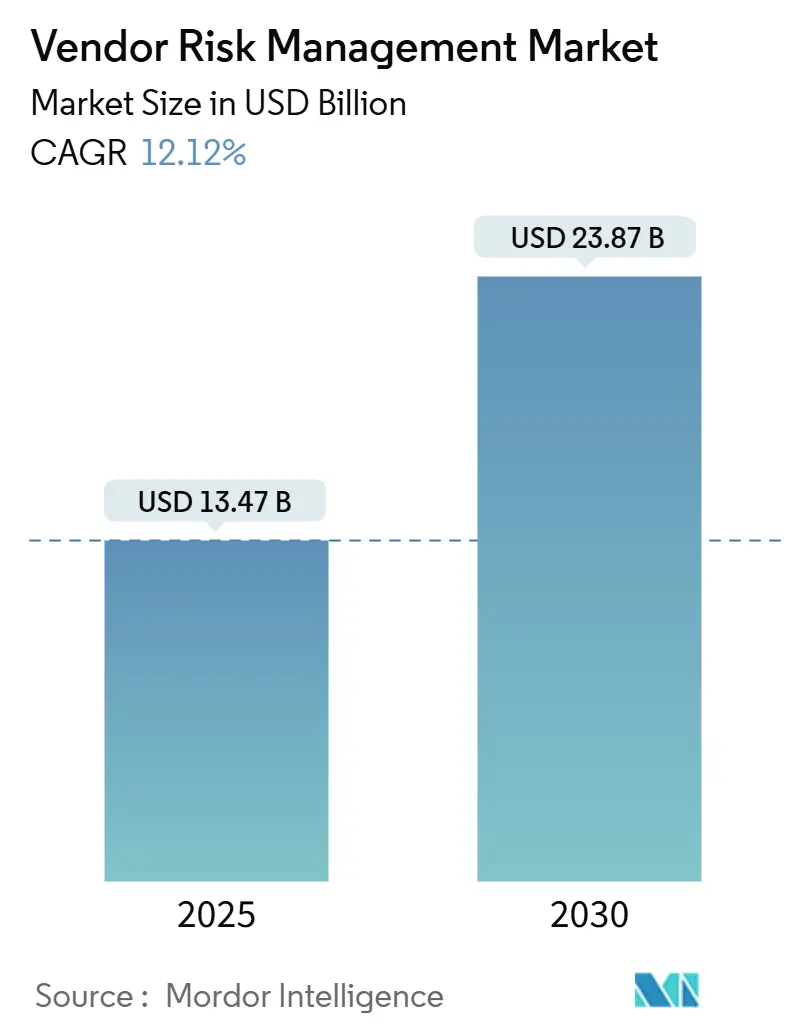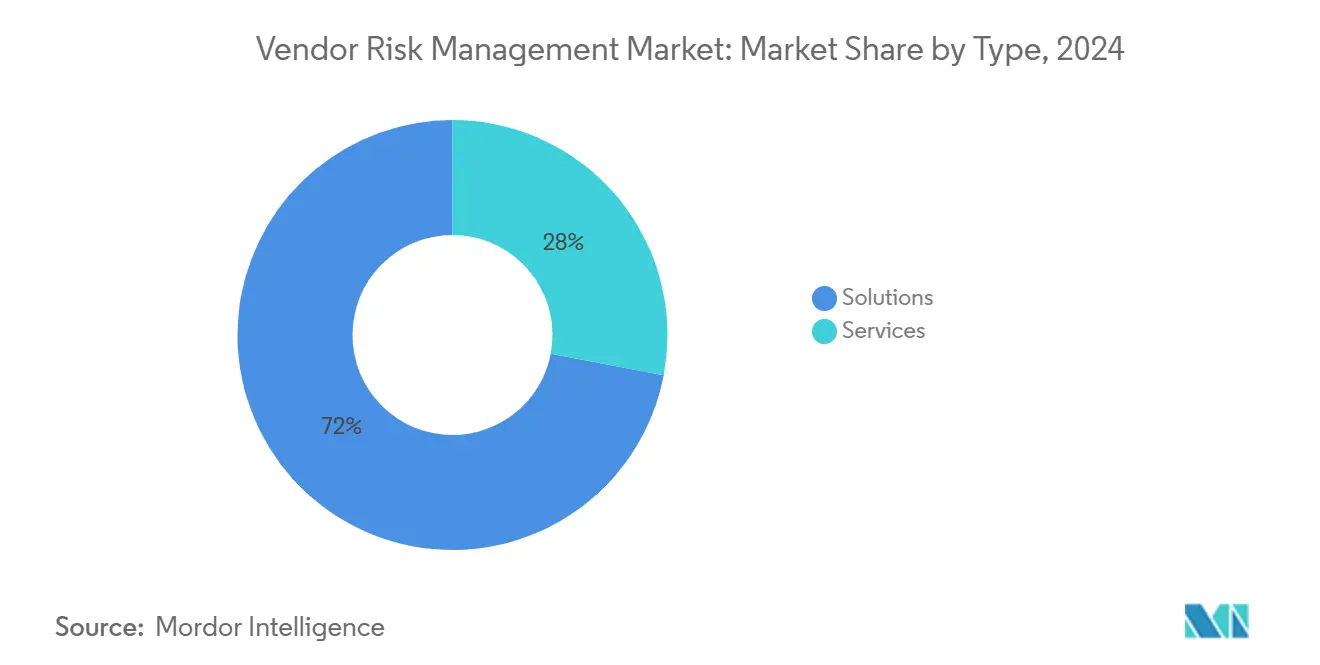Vendor Risk Management Market Size and Share
Vendor Risk Management Market Analysis by Mordor Intelligence
The vendor risk management market size is valued at USD 13.47 billion in 2025 and is forecast to reach USD 23.87 billion by 2030, reflecting a 12.12% CAGR. Growth is anchored in the shift from periodic, compliance-driven checks to continuous oversight as supply-chain cyber attacks intensify and regulators demand broader third-party visibility. Cloud deployment, the rise of ESG due diligence mandates, and widening vendor ecosystems in finance, healthcare, and manufacturing are expanding addressable demand. Providers are differentiating through AI-enabled analytics, industry-specific content, and modular architectures that lower adoption barriers for mid-market buyers. North America remains the largest regional buyer base, while Asia-Pacific generates the fastest incremental spend as digital-native firms scale multi-cloud estates.
Key Report Takeaways
- By type, solutions held 72% of the vendor risk management market share in 2024, while services are projected to expand at a 14.5% CAGR through 2030.
- By deployment model, cloud captured 65% of the vendor risk management market size in 2024 and is set to grow at a 15% CAGR to 2030.
- By organization size, large enterprises controlled 70% revenue in 2024; small and mid-sized enterprises are advancing at a 14% CAGR through 2030.
- By industry vertical, the BFSI segment led with 28% revenue share in 2024, whereas healthcare is forecast to rise at a 15.2% CAGR to 2030.
- By risk domain, operational risk accounted for 35% of the vendor risk management market size in 2024; ESG risk is the fastest-growing domain at 18% CAGR.
- By geography, North America commanded 35% revenue in 2024, while Asia-Pacific is projected to log a 14.2% CAGR between 2025 and 2030.
Global Vendor Risk Management Market Trends and Insights
Drivers Impact Analysis
| Driver | (~) % Impact on CAGR Forecast | Geographic Relevance | Impact Timeline |
|---|---|---|---|
| Escalating Supply-Chain Cyber-Attacks Triggering Enterprise-Wide 3rd-Party Risk Programs | +3.2% | North America, with spillover to Europe and Asia-Pacific | Medium term (2-4 years) |
| Proliferation of ESG Due-Diligence Mandates in EU Corporate Sustainability Reporting Directive | +2.5% | Europe, with global impact on multinational corporations | Long term (≥ 4 years) |
| Accelerated Cloud Adoption Complicating Vendor Footprints Among APAC Digital-Native Firms | +2.1% | Asia-Pacific, with influence on global cloud service providers | Medium term (2-4 years) |
| Banking Regulators' Heightened Scrutiny of Outsourcing Risk Fueling BFSI Spend | +1.8% | Global, with emphasis on North America and Europe | Short term (≤ 2 years) |
| Cost-Efficiency Gains From AI-Driven Continuous Vendor Monitoring Solutions | +1.5% | Global, with early adoption in North America | Medium term (2-4 years) |
| Emergence of Industry-Specific Vendor Risk Exchanges in Healthcare & Life Sciences | +1.3% | North America, with gradual expansion to Europe | Long term (≥ 4 years) |
Source: Mordor Intelligence
Escalating Supply-Chain Cyber-Attacks Triggering Enterprise-Wide Third-Party Risk Programs
Supply-chain cyber incidents surged by 431% between 2021 and 2023, elevating third-party risk to a strategic board priority. Manufacturing, healthcare, and finance now routinely integrate continuous monitoring, incident response playbooks, and collaborative procurement-security workflows. The UK Cyber Security Breaches Survey 2025 notes that 43% of firms endured a breach in the past year, and 85% involved phishing campaigns exploiting trusted vendors [1]UK Department for Science, Innovation and Technology, “Cyber Security Breaches Survey 2025,” gov.uk. Board-level visibility into supplier controls, attack-surface analytics, and real-time alerts is accelerating platform upgrades and favouring providers with AI-driven detection engines.
Proliferation of ESG Due-Diligence Mandates in EU CSRD
The Corporate Sustainability Reporting Directive broadened mandatory ESG disclosure to roughly 50,000 companies from January 2024, obliging risk teams to map and monitor environmental and human-rights exposure across supply chains. Firms must integrate greenhouse-gas, labour, and diversity metrics into vendor selection and continuously screen for adverse impacts. Coupled with the forthcoming Corporate Sustainability Due Diligence Directive, the rules prioritise traceability and remediation, spurring investments in platforms that unify financial, cyber, and ESG risk signals. Early adopters in automotive, retail, and pharmaceuticals are piloting shared assessment exchanges to streamline evidence collection.
Accelerated Cloud Adoption Complicating Vendor Footprints Among APAC Digital-Native Firms
Asia-Pacific’s digital-native enterprises often juggle several cloud service providers and hundreds of SaaS contracts, creating sprawling supplier estates. Misunderstandings around the shared-responsibility model persist, leading to under-protected workloads [2] ISACA, “Navigating Risk When Transitioning to the Cloud,” isaca.org. The Financial Services Sector Coordinating Council identifies transparency gaps and concentration risk, urging robust due diligence and contractual safeguards [4]Financial Services Sector Coordinating Council, “Cloud-Outsourcing Issues and Considerations,” sifma.org. Organizations are therefore standardising cloud-specific questionnaires, adopting multi-cloud visibility tools, and aligning supplier contracts with zero-trust architectures.
Banking Regulators’ Heightened Scrutiny of Outsourcing Risk Fueling BFSI Spend
The European Central Bank flags that over 30% of banks’ outsourcing budgets sit with only ten providers, heightening concentration risk [3]European Central Bank, “Rise in Outsourcing Calls for Attention – ECB Banking Supervision,” bankingsupervision.europa.eu. In the United States, amended Regulation S-P enforces stricter oversight of service firms handling consumer data beginning August 2024, while Europe’s Digital Operational Resilience Act sets new contractual standards from January 2025. Financial institutions are deploying integrated vendor risk suites capable of continuous control validation, automated evidence capture, and board-ready reporting to satisfy auditors and examiners.
Restraints Impact Analysis
| Restraint | (~) % Impact on CAGR Forecast | Geographic Relevance | Impact Timeline |
|---|---|---|---|
| Fragmented Vendor Data Taxonomies Hindering Interoperability Across Enterprise Systems | -1.2% | Global, with greater impact in regions with diverse regulatory frameworks | Medium term (2-4 years) |
| High Total Cost of Ownership for Integrated GRC Suites Among Mid-Market Organizations | -0.9% | Global, with particular impact on emerging markets | Short term (≤ 2 years) |
| Talent Shortage in Third-Party Risk Analysts Constraining Implementation Velocity in MEA | -0.7% | Middle East and Africa, with spillover effects globally | Medium term (2-4 years) |
| Perceived Data-Privacy Concerns Around Sharing Supplier Risk Scores With External Networks | -0.6% | Global, with heightened impact in regions with strict data protection laws |
Source: Mordor Intelligence
Fragmented Vendor Data Taxonomies Hindering Interoperability Across Enterprise Systems
Inconsistent metadata standards block seamless data exchange between procurement, contract, and ERP platforms. A Nature study underscores that ill-matched structures slow integration and limit analytics quality. Siloed formats force manual reconciliations, prolong implementation cycles, and dilute the value of predictive scoring. Global industry consortia are working on common ontologies, yet divergent privacy rules and legacy architectures mean progress will be gradual.
High Total Cost of Ownership for Integrated GRC Suites Among Mid-Market Organizations
Comprehensive governance, risk, and compliance platforms often require high subscription fees, complex configuration, and skilled staff, weighing on mid-market budgets. Vendors are responding with modular packages, managed-service options, and usage-based pricing, but initial costs and change-management demands still deter many buyers. As a result, some firms stay with spreadsheets or narrow point tools, slowing the broad adoption of unified vendor oversight.
Segment Analysis
By Type: Solutions Maintain Dominance While Service Engagement Climbs
Solutions accounted for 72% of vendor risk management market revenue in 2024 as firms prioritised core infrastructures such as vendor information management and compliance modules. The vendor risk management market size for solutions is projected to widen steadily, although organisations now demand AI-assisted document parsing and automated evidence gathering to cut analyst workloads. Services, spanning implementation, advisory, and managed operations, are gaining ground at 14.5% CAGR as buyers seek expertise to navigate sprawling regulations and integrate risk data streams.
Service uptake is strongest in healthcare and manufacturing, where in-house teams face resource gaps. Advisory partners assist with control mapping against CSRD, DORA, and sector-specific norms, while managed-service providers deliver continuous vendor surveillance. The shift indicates that talent shortages and heightened board expectations are pushing organisations toward hybrid delivery models blending software with expert support.
By Deployment Type: Cloud Acceleration Reshapes Implementation Models
Cloud delivery captured 65% of the vendor risk management market in 2024. Benefiting from rapid rollout, elastic scaling, and browser access, the vendor risk management market share for cloud platforms is projected to rise further as multinationals consolidate tools onto single stacks that serve global teams. Hybrid approaches persist where data-sovereignty obligations limit full migration, yet even highly regulated banks and insurers now use cloud for low-risk data processing and analytics.
On-premises installations remain important for defence, public-sector, and critical-infrastructure clients. However, cloud platform vendors are addressing concerns through dedicated hosting zones, encryption key management, and audit-ready logging. Growing confidence in shared-responsibility frameworks and improved contractual terms is reducing barriers, enabling organizations to phase critical workflows into secure cloud environments.
By Organization Size: Large Enterprises Lead While SMEs Catch Up
Large enterprises commanded 70% of 2024 spending as they oversee thousands of suppliers across multiple jurisdictions. One-third of major financial institutions now manage over 1,000 vendors, necessitating scalable workflows and extensive integration with procurement and security platforms. These buyers demand enterprise-grade configurability, extensive API libraries, and role-based analytics.
Small and mid-sized enterprises are forecast to expand spend at 14% CAGR as board directors recognise that third-party failures can threaten revenue and brand value. The Cybersecurity and Infrastructure Security Agency’s vendor-risk template for SMBs offers a lightweight starting point, helping firms ask the right questions and automate reminders. Suppliers are packaging off-the-shelf control libraries, guided questionnaires, and affordable continuous-scanning tiers that match the budget and skill realities of smaller teams.
By Industry Vertical: BFSI Sustains Leadership While Healthcare Accelerates
The BFSI sector held 28% of 2024 revenue due to stringent outsourcing oversight and the financial impact of service disruptions. European Central Bank reviews found multiple banks with non-compliant vendor contracts, prompting immediate remediation programmes. Institutions are embedding vendor risk analytics in procurement workflows, aligning exposure ratings with capital adequacy calculations and recovery planning.
Healthcare is set to rise at 15.2% CAGR as ransomware and patient-data breaches tied to business associates surge. Providers now require evidence of HIPAA safeguards, secure coding practices, and cyber insurance from suppliers. Industry consortia are piloting vendor-risk exchanges that allow hospitals to share assessment artefacts, reducing duplicative effort. Telecommunications, manufacturing, and government segments also deepened investments, driven by sustainability mandates and geopolitical supply-chain scrutiny.
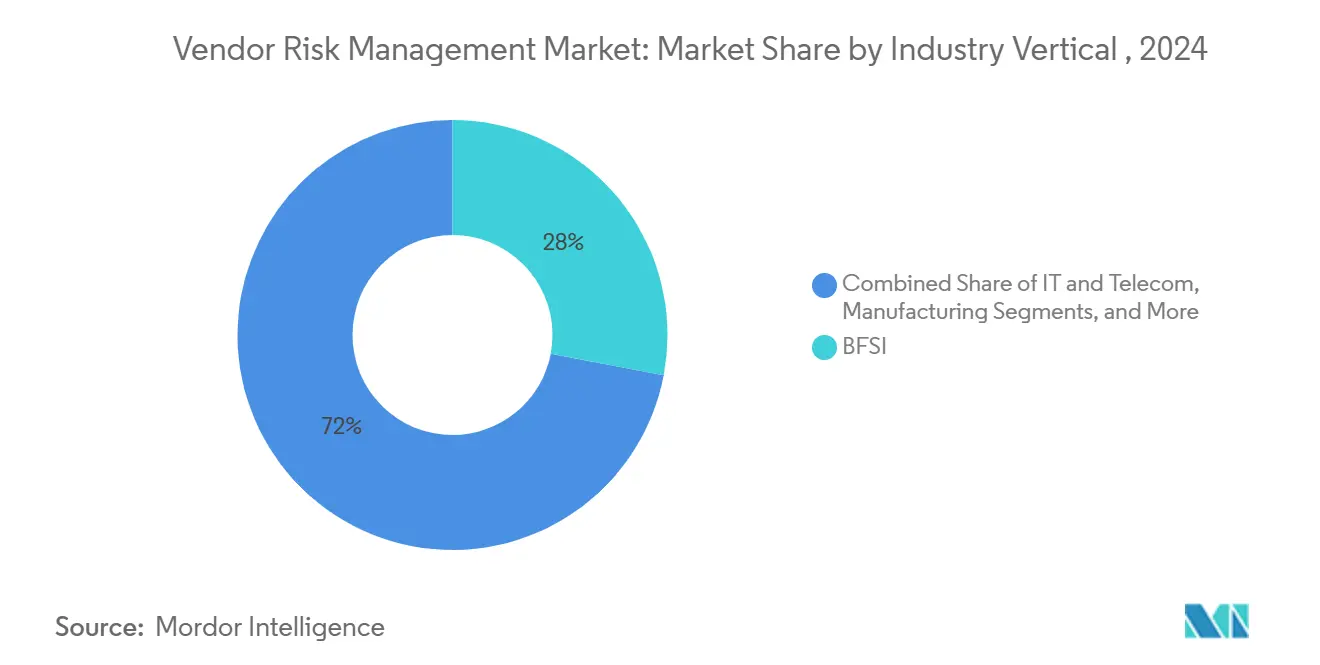
Note: Segment shares of all individual segments available upon report purchase
By Risk Domain: Operational Risk Dominates While ESG Surges
Operational risk retained a 35% share in 2024, reflecting the universal need for uninterrupted service delivery. Downtime penalties and lost revenue compel organisations to scrutinise supplier resiliency, capacity planning, and incident history. Real-time key-performance indicators and scenario dashboards support proactive escalation.
ESG risk is the fastest riser with 18% CAGR as investors and regulators link sustainability performance to enterprise value. CSRD, CSDDD, and similar rules necessitate granular mapping of labour practices, carbon output, and anti-corruption controls across tiers. Platforms now ingest supplier-reported metrics, satellite imagery, and whistle-blower feeds to score ESG posture. Cybersecurity, compliance, and financial-health domains remain critical, but integrated views across categories enable more balanced sourcing decisions.
Geography Analysis
North America generated 35% of 2024 revenue, supported by rigorous privacy law enforcement and mature financial and healthcare ecosystems. The SEC’s revised Regulation S-P obliges financial services firms to document vendor oversight and incident workflows, spurring technology upgrades. Healthcare providers contend with a 287% surge in breaches routed through business associates, prompting greater allocation to continuous scanning and contract hygiene.
Asia-Pacific is the fastest-growing region at 14.2% CAGR. Rapid cloud adoption, new data-protection statutes, and heightened enforcement in markets such as Singapore and India push enterprises to formalise supplier oversight. Regional security spending is projected to reach USD 52 billion by 2027, and multinational corporations often pilot unified vendor risk management programmes in their APAC subsidiaries to harmonise global standards.
Europe’s trajectory is shaped by CSRD and the 2025 introduction of DORA. Large firms must map environmental and human-rights impacts across extended supply chains, while banks are required to update critical-service contracts under new resilience rules. Data-transfer constraints under GDPR and upcoming AI governance laws further raise the compliance bar, increasing demand for centralised repositories, automated evidence workflows and auditable decision trails.
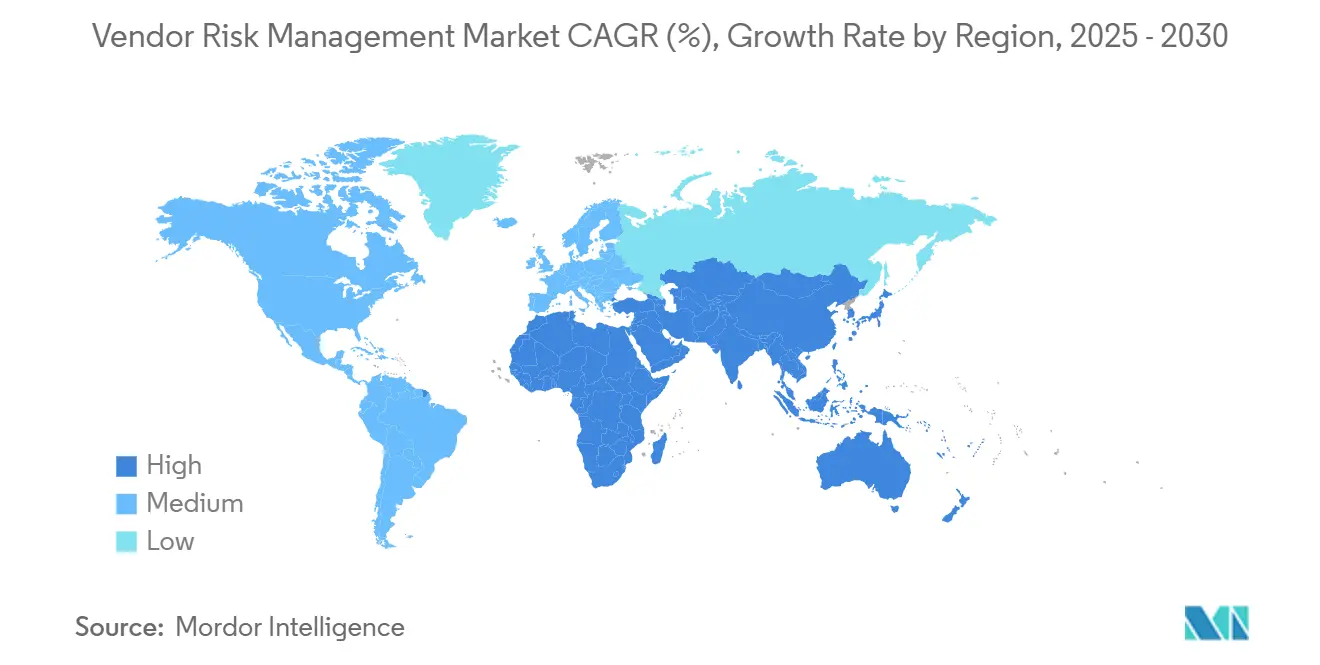
Competitive Landscape
The vendor risk management market features a blend of enterprise software giants, focused risk-tech specialists, and venture-backed innovators. Leading platforms integrate continuous rating feeds, contract lifecycle management, and policy mapping into configurable workspaces. MetricStream’s 2025 partnership with Glencore illustrates demand for industry-tuned content, combining mining-specific ESG metrics with global audit workflows. ServiceNow, Coupa, and SAP extend procurement and IT-service roots to embed vendor-risk dashboards in existing user interfaces, reducing change-management friction.
AI-native entrants automate document extraction, control mapping, and predictive scoring, lowering analyst workloads amid a widening talent gap. Some providers are experimenting with blockchain-secured assessment ledgers to eliminate duplicate attestations and to prove data integrity. Meanwhile, managed-service specialists target mid-market buyers that lack in-house bandwidth, bundling technology, analyst expertise, and compliance reporting in subscription packages. Competitive intensity is driving module unbundling, value-based pricing, and increased openness through APIs and standard data models.
Vendor Risk Management Industry Leaders
-
RSA Security LLC
-
Genpact Limited
-
Lockpath (NAVEX)
-
MetricStream Inc.
-
IBM Corporation
- *Disclaimer: Major Players sorted in no particular order
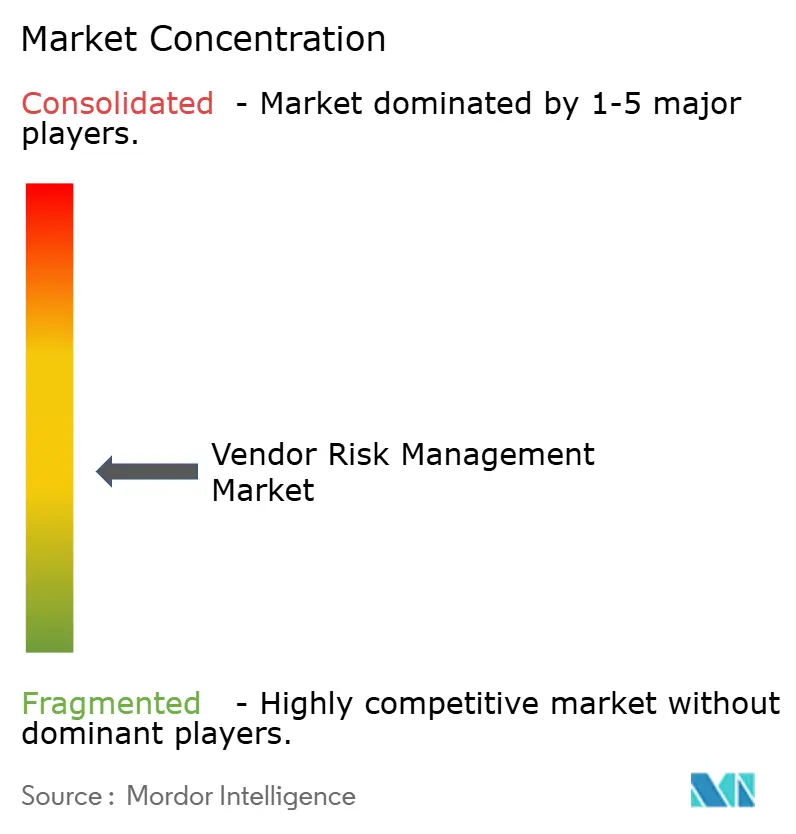
Recent Industry Developments
- May 2025: Venminder reported that 41.8% of fintech breaches stem from third parties, underscoring personnel security gaps in the sector.
- April 2025: MetricStream partnered with Glencore to deepen risk, audit, and compliance programmes across mining operations.
- March 2025: TrustCloud rolled out AI-driven third-party risk assessment features to streamline evidence reviews and scoring.
- January 2025: Censinet launched continuous monitoring and controls validation modules tailored to healthcare vendor ecosystems.
Global Vendor Risk Management Market Report Scope
Vendor Risk management focuses on the uncertainty, probability, and consequence of various threats to both a company’s bottom line and its ability to deliver goods and services on time. Risk management enables companies to prepare for unexpected risks resulting from third-party vendors and suppliers. VRM programs are concerned with ensuring third-party products, IT vendors, and service providers do not result in business disruption or financial and reputational damage.
The Vendor Risk Management Market is segmented into type (solution [vendor information management, quality assurance management, financial control, compliance management, audit management, and contract management], services), deployment mode (cloud, on-premises), organization size (small and medium-sized enterprises, large enterprises), end-user industry (banking, financial services, and insurance, telecom and IT, manufacturing, government, and healthcare) and geography (North America, Europe, Asia Pacific, Latin America, and Middle East and Africa). The report offers market forecasts and size in value (USD) for all the above segments.
| By Type | Solutions | Vendor Information Management | |
| Quality Assurance Management | |||
| Financial Control | |||
| Compliance Management | |||
| Audit Management | |||
| Contract Management and Others | |||
| Services | Professional Services | ||
| Managed Services | |||
| By Deployment Type | On-Premises | ||
| Cloud | |||
| By Organization Size | Small and Medium-Sized Enterprises | ||
| Large Enterprises | |||
| By Industry Vertical | Banking, Financial Services and Insurance (BFSI) | ||
| IT and Telecom | |||
| Manufacturing | |||
| Government | |||
| Healthcare | |||
| Others (Energy and Utilities, and Retail and Consumer Goods) | |||
| By Risk Domain | Cybersecurity Risk | ||
| Financial Risk | |||
| Operational Risk | |||
| Compliance Risk | |||
| ESG / Sustainability Risk | |||
| By Geography | North America | United States | |
| Canada | |||
| Mexico | |||
| South America | Brazil | ||
| Argentina | |||
| Chile | |||
| Peru | |||
| Rest of South America | |||
| Europe | Germany | ||
| United Kingdom | |||
| France | |||
| Italy | |||
| Spain | |||
| Rest of Europe | |||
| Asia-Pacific | China | ||
| Japan | |||
| South Korea | |||
| India | |||
| Australia | |||
| New Zealand | |||
| Rest of Asia-Pacific | |||
| Middle East and Africa | United Arab Emirates | ||
| Saudi Arabia | |||
| Turkey | |||
| South Africa | |||
| Rest of Middle East and Africa | |||
| Solutions | Vendor Information Management |
| Quality Assurance Management | |
| Financial Control | |
| Compliance Management | |
| Audit Management | |
| Contract Management and Others | |
| Services | Professional Services |
| Managed Services |
| On-Premises |
| Cloud |
| Small and Medium-Sized Enterprises |
| Large Enterprises |
| Banking, Financial Services and Insurance (BFSI) |
| IT and Telecom |
| Manufacturing |
| Government |
| Healthcare |
| Others (Energy and Utilities, and Retail and Consumer Goods) |
| Cybersecurity Risk |
| Financial Risk |
| Operational Risk |
| Compliance Risk |
| ESG / Sustainability Risk |
| North America | United States |
| Canada | |
| Mexico | |
| South America | Brazil |
| Argentina | |
| Chile | |
| Peru | |
| Rest of South America | |
| Europe | Germany |
| United Kingdom | |
| France | |
| Italy | |
| Spain | |
| Rest of Europe | |
| Asia-Pacific | China |
| Japan | |
| South Korea | |
| India | |
| Australia | |
| New Zealand | |
| Rest of Asia-Pacific | |
| Middle East and Africa | United Arab Emirates |
| Saudi Arabia | |
| Turkey | |
| South Africa | |
| Rest of Middle East and Africa |
Key Questions Answered in the Report
What is the current value of the vendor risk management market?
The market is valued at USD 13.47 billion in 2025 and is projected to reach USD 23.87 billion by 2030.
Which region is growing the fastest?
Asia-Pacific posts the highest forecast CAGR at 14.2% due to rapid digitalisation and evolving regulatory pressure.
Why are cloud deployments preferred for vendor risk management?
Cloud models offer rapid implementation, elastic scalability and seamless updates, enabling 65% of organisations to adopt them in 2024 and grow usage at 15% CAGR.
Which industry vertical spends the most on vendor risk oversight?
Banking, financial services and insurance lead with 28% of 2024 revenue, reflecting strict outsourcing rules and high cyber exposure.
What is driving the rise in ESG-focused vendor assessments?
The EU Corporate Sustainability Reporting Directive requires extensive disclosures across value chains, pushing firms to integrate ESG metrics into supplier selection and monitoring, driving the ESG risk domain at an 18% CAGR.
How do AI capabilities improve vendor risk programmes?
AI automates document review, detects anomalies and delivers continuous monitoring, allowing enterprises to scale oversight despite a shortage of specialised analysts.

